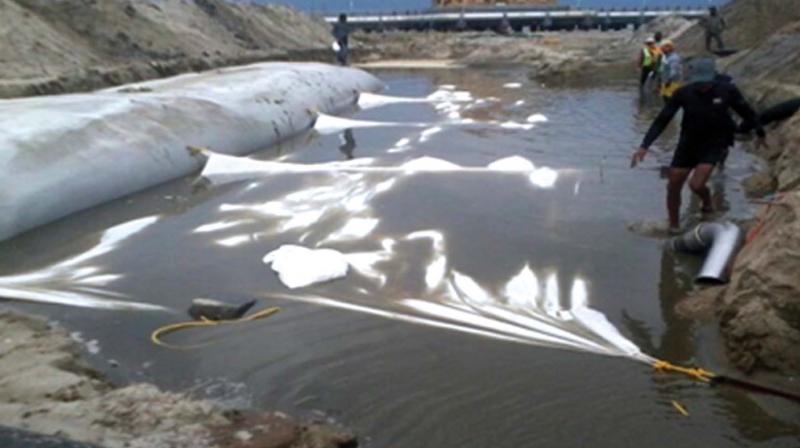Geo-synthetic structures, the best option

The uncertain and extreme events due to climate change demands that Kerala develop adaptation strategies for coastal protection. They must be innovative, blending with the environment and at the same time serving the purpose.
The use of rubble-mound structure (sea wall) has been tested since long but considering the challenges faced in using them, it is imperative that alternatives such as geo-synthetic structures be thought of. Geo-synthetic systems (geo-synthetic tubes/bags) are flexible, cost-effective and blends with the environment and are specially conducive for temporary structures such seawalls that require frequent replacement due to the impact of extreme events. However, extreme care must be taken while deciding on the size and length of the structures.
What are geo-synthetic systems?
Geo-synthetic systems are three-dimensional systems made with geo-synthetic material (woven and/or nonwoven materials), usually assembled by stitching, and then filled with sand or other types of soil. The two types of geo-synthetic systems used for coastal protection are geo synthetic tubes and geo-synthetic bags.
The geo-synthetic tubes and bags are made of geo-synthetic fabrics which are synthetic polymer fabrics used in a soil (geo) environment and include woven, knitted and non-woven polymeric materials and manufactured using textile processes. They are usually made from one of the four synthetic polymers: polyamide, polyester, polyethylene, and polypropylene. Polyester and polypropylene are generally used in coastal protection projects.
Geo-synthetic bags are available in volume from 0.05 m3 to around 5 m3 while geo-synthetic tubes range in size from 1m to 10m in diameter and lengths up to 200m. The generally used lengths are between 20 m to 30 m and the volume of fill range from 5 m3 to 100 m3.
Why geo-synthetic tubes are suitable?
As per the coastal statistics report (National Hydrographic Survey, Dehradun, India), India has a main land coast length of 5421 km (excluding the island states). The coastal length that is prone to erosion in the west coast of India is 36 per cent against 8 per cent length in the east coast; this is because the extreme events of waves and currents are more predominant in the west coast against tidal surges and cyclones in the east coast. As much as 80 per cent of the coastal stretch of Kerala is categorised as sandy coast and geo-synthetic tube structures have a major role to play if properly selected as per site conditions. Extensive research reveals that geo-systems are a serious alternative to rubble mound structures to prevent erosion in the sandy coasts.
A successful model at Neerkunnam
The state government funded a pilot project in 2016 for a 100 m-stretch along Neerkunnam in Ambalapuzha coast, which was severely affected by sea attack during the earlier years. The construction was over in May 2016 before the coastal erosion during the monsoon 2016 commenced.
The structure consisted of three geo-synthetic tubes (20m length and 3 m diameter): two tubes below the ground level and one above. It is important to note that the bottom level at which the tube rests is an important aspect .The sand excavated for laying the tubes below the ground was used for filling the tubes using sand slurry pumps. The design was the same as provided by CWPRS, Pune for Petronet LNG at Puthuvypeen. The structure has been subjected to severe sea attack twice every year including the Oakhi cyclone attack in 2018. This stretch of the coast has been safe from calamities after the installation of the geo-synthetic structure. The cost involved for the execution of the structure was only one third of what is spent by the department for constructing a new rubble structures. The pilot project was undertaken adjacent to a seawall reformed so that the cost comparison on the maintenance could also be undertaken.
After the structure was installed no maintenance has been undertaken so far by the department but the seawall had been reformed 3 times.
Chellanam, the failed experiment
A similar venture to protect the Chellanam coast using geo-synthetic tubes was initiated during the monsoon in 2018. The project was faulty on many counts: the choice of a 25 metre long, 5-metre diameter tube was not a proper one; sand availability became an issue; there was widespread protest against excavating sand.
Normally, tubes with a diameter larger than 3 metres are filled with sand taken from the sea bed offshore. But such a move would worsen sea attack in a place such as Chellanam. A smaller sized tube would have obviated that trouble.
(The writer, a consultant on coastal engineering, supervised laying of geo-synthetic structures at several spots across west coast. He can be contacted at akglet1958@gmail.com)

